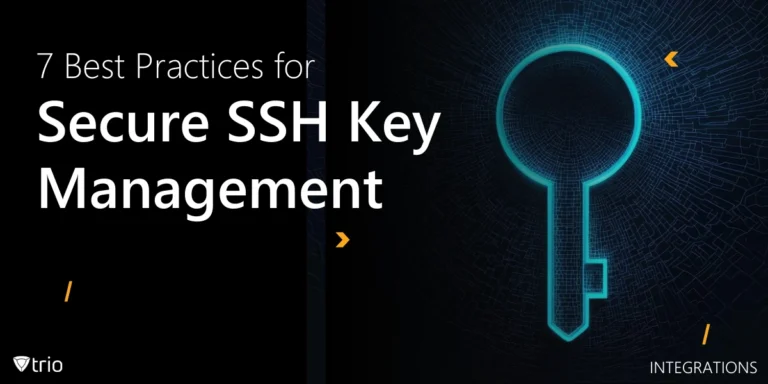Kandji has long been a go-to solution for Apple device management, offering robust features tailored to macOS and iOS environments. However, organizations seeking broader platform support, enhanced automation, or more flexible pricing structures may find themselves exploring alternatives to implement a new Mobile Device Management project plan. In this post, we’ll delve into five compelling Kandji alternatives—starting with Trio—and provide an in-depth look at each to help you make an informed decision.
1. Trio – Unified Endpoint Management with Advanced Security
Trio stands out as a comprehensive endpoint management solution that extends beyond traditional Mobile Device Management capabilities. It offers a unified platform to manage devices across various operating systems, including macOS, Windows, and Linux. Trio’s architecture is designed to streamline IT operations by integrating device management with advanced security features.
One of Trio’s key strengths is its built-in vulnerability management and endpoint detection and response (EDR) capabilities. This integration allows IT teams to proactively identify and mitigate security threats without relying on multiple disparate tools. Additionally, Trio’s compliance monitoring tools assist organizations in adhering to industry standards such as SOC 2, HIPAA, and ISO 27001.
Trio also simplifies the onboarding and offboarding processes through automation, ensuring that devices are configured correctly from the outset and securely decommissioned when no longer in use. This automation reduces the administrative burden on IT staff and minimizes the risk of human error.
For organizations interested in experiencing Trio’s capabilities firsthand, the platform offers a demo account and a free trial period. This opportunity allows potential users to explore the interface, test features, and assess how one of Kandji’s competitors fits within their existing IT infrastructure.
Pros:
- Supports multiple operating systems (macOS, Windows, Linux)
- Integrated vulnerability management and EDR
- Compliance monitoring for industry standards
- Automated onboarding and offboarding processes
Cons:
- May require a learning curve for teams new to unified endpoint management
- Advanced features might be more than needed for smaller organizations
2. NinjaOne – Comprehensive IT Management Across Platforms
As an alternative to Kandji, NinjaOne offers a robust IT management platform that encompasses device management, patching, monitoring, and remote support. Unlike Kandji, which focuses exclusively on Apple devices, NinjaOne provides support for Windows, macOS, and Linux, making it suitable for heterogeneous IT environments.
The platform’s unified dashboard allows IT teams to monitor and manage all endpoints from a single interface. NinjaOne’s automation capabilities streamline routine tasks such as software deployment and patch management, freeing up IT resources for more strategic initiatives.
NinjaOne also emphasizes security, offering features like real-time monitoring and automated remediation to quickly address potential issues. Its integration capabilities enable seamless connectivity with other tools and systems, enhancing overall operational efficiency.
With a 14-day free trial and comprehensive onboarding support, NinjaOne provides organizations with the resources needed to evaluate its suitability for their specific needs.
Pros:
- Supports Windows, macOS, and Linux
- Unified dashboard for comprehensive endpoint management
- Strong automation and integration capabilities
- Emphasis on security with real-time monitoring
Cons:
- May be more feature-rich than necessary for small businesses
- Pricing information is not publicly disclosed
3. Scalefusion – Kandji Alternatives for Android and Other Devices
Scalefusion offers a unified endpoint management solution designed to manage a wide range of devices, including Android, iOS, macOS, Windows, Linux, and ChromeOS. This broad compatibility makes it an attractive option for organizations with diverse device ecosystems.
The platform provides features such as role-based access control, web content filtering, and automated OS updates. Scalefusion’s integration with identity providers simplifies user authentication, while its endpoint security solution, Veltar, adds an extra layer of protection for corporate data.
Scalefusion’s intuitive interface and ease of deployment make it accessible for organizations of varying sizes. Its scalability ensures that it can accommodate growing IT needs without significant overhauls.
Pros:
- Supports a wide range of operating systems
- Comprehensive feature set including security and compliance tools
- User-friendly interface with easy deployment
- Affordable pricing with scalable plans
Cons:
- Some advanced features may require additional configuration
- Support for certain niche devices may be limited

4. Addigy – Apple-Focused Management with Real-Time Monitoring
Addigy specializes in Apple device management, offering a cloud-based platform tailored for macOS and iOS environments. Its real-time monitoring and automation capabilities provide IT teams with immediate visibility and control over their Apple devices.
Key features include zero-touch provisioning, asset management, and automated remediation. Addigy’s LiveDesktop feature allows for remote troubleshooting, enhancing support efficiency. The platform also supports custom scripting, enabling deeper automation and customization.
Addigy’s multi-tenant architecture makes it suitable for managed service providers (MSPs) and enterprise IT teams managing multiple clients or departments. Its focus on Apple devices ensures that it stays up-to-date with the latest developments in the Apple ecosystem.
Pros:
- Competitive pricing, especially for educational institutions and small businesses
- Strong focus on Apple devices with specialized solutions for education and enterprise
- Offers both MDM and endpoint security features in a unified platform
- Automates device onboarding, app deployment, and compliance enforcement
Cons:
- Limited support for non-Apple devices, making it less suitable for mixed OS environments
- Advanced security features are only available in premium plans
- User interface may have a learning curve for new IT admins
- Limited third-party integration compared to more flexible solutions like Trio
5. Jamf Pro – Enterprise-Grade Apple Device Management
Jamf Pro is a leading solution for organizations deeply embedded in the Apple ecosystem. Designed specifically for macOS, iOS, iPadOS, and tvOS devices, Jamf Pro offers comprehensive tools for device deployment, inventory management, and security enforcement. Its seamless integration with Apple services ensures that IT administrators can efficiently manage and secure Apple devices across their organization.
A standout feature of Jamf Pro is its zero-touch deployment capability, allowing devices to be configured and ready for use right out of the box. This, combined with robust inventory tracking and automated patch management, streamlines the IT workflow. Additionally, Jamf Pro’s Self-Service app empowers end-users by providing a curated catalog of IT-approved apps and resources, reducing the dependency on IT support for routine tasks.
Security is a cornerstone of Jamf Pro, with features like endpoint protection, threat prevention, and compliance management. The platform also supports integration with identity providers, facilitating single sign-on (SSO) and enhancing access control. For organizations prioritizing security and compliance, Jamf Pro offers tools to enforce policies and monitor device health continuously.
Pros:
- Tailored specifically for Apple devices, ensuring deep integration
- Robust security features, including endpoint protection and compliance tools
- Zero-touch deployment and automated patch management
- Self-Service app enhances end-user autonomy
Cons:
- Limited to Apple devices; not suitable for mixed-device environments
- Pricing may be higher compared to other MDM solutions
Conclusion
If you’re seeking a versatile and comprehensive device management solution that caters to diverse operating systems and offers advanced security features, Trio stands out as a compelling choice. With its user-friendly interface, automated compliance tools, and seamless integration capabilities, Trio is designed to meet the dynamic needs of modern IT environments.
Experience the full range of Trio’s features firsthand by requesting a free demo and activating a 14-day trial. This opportunity allows you to explore how Trio can streamline your device management processes and enhance security across your organization.
Get Ahead of the Curve
Every organization today needs a solution to automate time-consuming tasks and strengthen security.
Without the right tools, manual processes drain resources and leave gaps in protection. Trio MDM is designed to solve this problem, automating key tasks, boosting security, and ensuring compliance with ease.
Don't let inefficiencies hold you back. Learn how Trio MDM can revolutionize your IT operations or request a free trial today!




